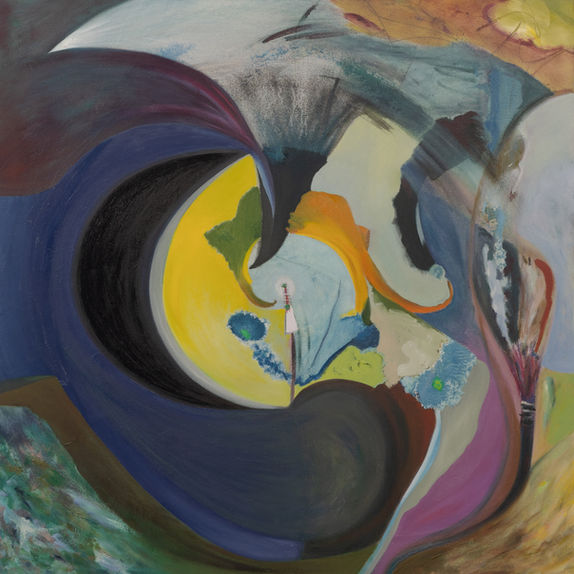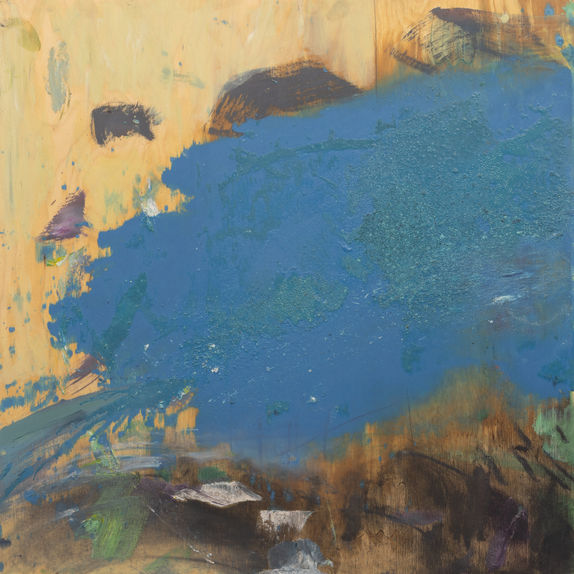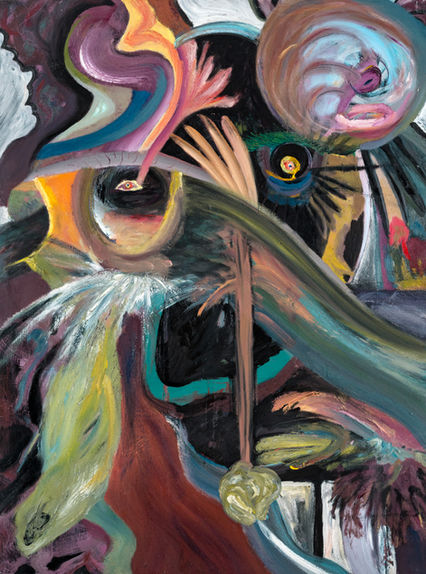
אזור הַחַיּוּת
אסף הינדן
בתערוכתו החדשה "אזור הַחַיּוּת", מציג דן דן בשי מערך ציורי שמן ואקריליק שנוצרו בשנים האחרונות בסטודיו שלו בקיבוץ קטורה שבערבה הדרומית. העבודות נולדו מתוך דיאלוג מתמשך עם הנוף הגיאולוגי סביבו – ארכיון חי של היסטוריה ארוכת שנים שמניע אותו ליצור. בשי אוסף ובוחן סלעים ומאובנים מסביבתו, שרידים של קיום קדום – לא כחוקר שמנתח, ממפה או מבקש לקבוע עמדה – אלא כחלק מחיפוש אחר התהוות של חומר וזמן, דימוי, צורה ומהות. מתוך הקשבה ממושכת לסביבתו, ובאמצעות הצטברות של שכבות ופעולות, בשי מתעסק בתהליך הפנימי של הציור עצמו. הוא עובד על כל ציור במשך זמן ממושך בפעולה שכבתית: מתחיל, עוצר, עורך, מוסיף, מוחק, חושף. אופן הפעולה שלו מהדהד את ההתאבנות עצמה: חומר אורגני שהיה פעם חי מתחלף בחומר מינרלי מבלי לאבד את צורתו, שכן האמן מתרגם רשמים וזיכרונות לשפה חומרית תוך שמירה על מהותם הפנימית. השכבות הרבות והעבודה המתמשכת חושפות מגוון תהליכים שמשקפים את המעברים המורכבים של החומר בדרכו להפוך למאובן – משהו חי משנה את צורתו ומתקבע בנוף ובסביבה, מבלי שנדע איך הוא ייראה, מתי יתגלה, ומי יגלה אותו. בשי מתעניין ברגע שבו החומר עובר טרנספורמציה – במתח שבין קביעות לשינוי, בין ההווה להיסטוריה. הוא נמשך למצב ביניים, ולמקום שבו תהליכים גיאולוגיים ויצירתיים נפגשים ומשפיעים זה על זה. התהליך שלו אינו לינארי; לעיתים הוא נקטע, מתפצל, נפתח מחדש. העבודות עצמן מתקיימות בתוך אותו מרחב של יציבות זמנית, והציור לעיתים משקף הלך רוח מושהה – כמעט מתחמק מהרגע שבו יהפוך ליצירה ״ממושמעת״ שתלויה על קירות הגלריה. השכבות שמצטברות במהלך העבודה – חלקן נראות וחלקן רק מורגשות – מאפשרות לעבור בין מצבי קריאה שונים ולהציע יותר מדימוי אחד. העבודות משמרות את אי־הוודאות כעקרון יצירתי של בשי. מרביתן לא מרמזות בהכרח על נוכחות מדברית, ולא מבשרות על תנאי השטח שבסביבתו של האמן. בשי מותיר את העבודות ללא סממני זמן ומקום מובהקים: לעיתים נדמה שמדובר בזיכרון נופי מעורפל, ולעיתים בפרגמנט מחלום; הבזק מתוך הזיה פסיכדלית או תודעה משתנה. הקומפוזיציות המופשטות מטשטשות גם שאלות קונקרטיות סביב קנה מידה, תקריב או "תרחיק", כך שהדימוי עובר טרנספורמציות נוספות, כמו אלה שהפעילו את האמן בשיטוטיו הרבים. לא תמיד ברור אם אנחנו צופים במה שכבר נשחק, במה שעדיין מתהווה, או במה שמבקש להופיע מחדש. ואולי זה מה שמניע את בשי: לא לתאר את מה שהיה או לדמיין נרטיב של מה שיהיה, אלא ללכוד את התהליך שבו משהו עומד להתגלות, או עומד להיעלם. בעבודותיו, הציור אינו יעד סופי, אלא מצב צבירה מתמשך שבו זיכרון, חומר ודמיון מתערבבים זה בזה ומשאירים עקבה פתוחה. בדומה לפני סלע שנחרצו באיטיות, עבודותיו נוצרות את סיפורן בשכבות – כאלה שלא תמיד ניתן או צריך לפענח. האזור הגיאוגרפי שבו הוא פועל, שעשוי להידמות תחילה למרחב דומם או עירום, מלא בחַיּוּת מורכבת וסבלנית שלעיתים נסתרת מהנוף. כמוהו, כך גם הדימויים של בשי אינם נלכדים במבט אחד, ובכך מאפשרים לצופה להיענות להזמנה של האמן: לחוות את מרחב ההתבוננות שהוא מציע ולשהות בו.
Vitality Field
Assaf Hinden
In his new exhibition, Vitality Field, Dan Dan Bashi presents a collection of oil and acrylic paintings created over the past few years in his studio on Ketura Kibbutz in the southern Arava. The works emerged from an ongoing dialogue with the geological landscape surrounding him – a living archive of a years-long history that inspires him to create. Bashi collects and examines rocks and fossils from his environment – remnants of an ancient existence – not as a researcher who analyses, maps, or seeks to make a stand, but as part of his search for the formation of matter and time, an image, form and essence. Through continual attentiveness to his surroundings, and by forming a compilation of strata and actions, Bashi engages with the inner process of painting itself. Each work evolves over a prolonged period and through stratification: starting, pausing, editing, adding, erasing, exposing. His method of working echoes the process of fossilization: Once-living organic matter transforms into a mineral substance without losing its form – just as the artist translates impressions and memories into a material language while preserving their inner essence. The numerous layers and ongoing work reveal a range of processes that mirror the complex transformations matter undergoes as it turns into a fossil – a living entity transforms and becomes fixed within the landscape and environment, and no one can tell how it will eventually look, when it will be unearthed, and by whom. Bashi is interested in the moment when matter is transformed – in the tension between fixation and change, between the present and history. He is drawn to the in-between, the place where geological processes encounter creative ones, one influencing the other. His process is not linear: it is often disrupted, split, reopened. The works themselves exist within this state of temporary stability; the painting often reflects a suspended state of mind, as if resisting the moment when it becomes “obedient,” hanging on the gallery walls. The layers that accumulate throughout the process – some visible, others only sensed – allow a shift between different interpretations, offering more than a single image. The works preserve uncertainty as a creative principle of Bashi’s. Most of them do not necessarily allude to a desert presence, nor do they convey the terrain surrounding the artist. Bashi leaves the works without a distinct indication of time and place: They seem at times to evoke a vague memory of a landscape, at others a fragment of a dream; a flash of psychedelic illusion or shifting consciousness. The abstract compositions also blur concrete questions of scale, whether close-up or distant, allowing the image to undergo further transformation, much like those that propel Bashi in his constant wandering. It is not always clear whether we are seeing something already eroded, something still coming into being, or something yearning to reemerge. And perhaps this is what motivates Bashi: not to describe what was or imagine a narrative of what will be, but to capture the process of something that is about to be uncovered or about to disappear. In his work, the painting is not a final destination but a continual state where memory, matter and imagination fuse, leaving an open trace. Like a rock slowly etched over time, his works unfold their story in layers – layers that are not always decipherable, nor necessarily meant to be. The geographical area in which he operates, seemingly still or bare at first glance, is full of complex, patient vitality, often hidden from view. Like this landscape, Bashi’s images are not captured in a single glance, thus allowing the viewer to accept his invitation to experience and dwell in the space of observation he offers.




























